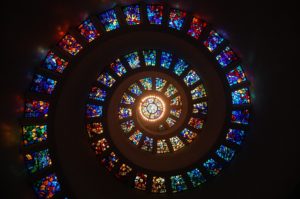 Image by msandersmusic
Image by msandersmusic
Transplant surgeons are pretty brilliant. They need complicated, intricate, delicate, sensitive skills to explore, cut the right not the wrong things, and find the ways to fix it all back together again so the body can get on with its even more incredible job of healing and looking after itself. There are miracles happening every day in those transplant theatres. But try and say thanks to them and some of them will tell you, “I’m only a plumber, I just disconnect and reconnect the pipes that keep us going.”
But for all that, disconnecting and reconnecting the optic nerve is still not quite in reach. Over a million nerve fibres bundled together in that tiny strand that connects your eye to your brain. Through those tiny fibres travels all the information that starts as bits of reflected light. Most of us take it in second-by-second, in through the cornea, the pupil, the iris, and the lens until it’s all projected onto the retina, the screen at the back of your eye. Then it’s transformed into electrical impulses and whizzes off along those million or so nerve fibres to various bits of your brain. And, because the eye lenses are curved, the light that comes in gets flipped upside down. Your brain turns it the other way up again so it will make some kind of practical sense for you. Your brain also layers the information from one eye over that from the other and turns it from 2D into 3D, so it can work out depth perception. That helps when someone throws you a ball. And a few other things.
Enough of the amateur science, though it is an amazing world to look around in and see more of how it might all work. Maybe because most of us know how vital our sight is to the way we experience ourselves, each other and our world – even if we often take for granted something that visually impaired people must experience very differently – it’s not surprising that when it comes to ticking that box about donating our eyes it can get a bit weird. Understandable, but…
Eye donation is really cornea donation. The cornea is the clear windowpane on the front of your eye. It’s not the coloured bits that make your eyes unique to you, as unique as your fingerprints. And until surgeons are able to reconnect the more than a million fibres in your optic nerve and help it to start working again, whole eyes won’t, can’t, be transplanted. It’s that clear windowpane on the front that can be transplanted instead. That’s it. In ten years or so you might need to check that again because medical scientists don’t usually give up trying just because something seems impossible, but for now at least, nobody else will be able to see things through your eyes. Can’t be done.
And then, of course, we do really know that when our brains stop working, it doesn’t matter how much light is shone into our eyes, they won’t see again. We won’t be needing them.
But somebody else might be able to benefit from those tiny windowpanes. With them, they could begin to see again. All those things we see and take for granted. You don’t need a list of what they are, just think of what you are lucky enough to be able to see. How precious and vital that is.
So, while we’re talking to our families and friends about our wishes for organ donation, if someone asks if we’d also be willing to donate our corneas should that rare situation ever arise, might we just look them in the eye, smile, and say “Yes”?
